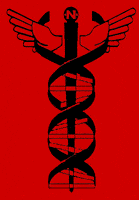

© Copyright 2000-2002, Robert A. Freitas Jr.
All rights reserved.
A nanorobotic device that could safely provide quick and complete eradication of bloodborne pathogens using relatively low doses of devices would be a welcome addition to the physician’s therapeutic armamentarium. Such a machine is the microbivore, an artificial mechanical phagocyte designed by Robert A. Freitas Jr.
The microbivore is an oblate spheroidal nanomedical device consisting of 610 billion precisely arranged structural atoms plus another ~150 billion mostly gas or water molecules when fully loaded. The nanorobot measures 3.4 microns in diameter along its major axis and 2.0 microns in diameter along its minor axis, thus ensuring ready passage through even the narrowest of human capillaries which are ~4 microns in diameter. Its gross geometric volume of 12.1056 micron3 includes two normally empty internal materials processing chambers totalling 4 micron3 in displaced volume. The nanodevice consumes 100-200 pW of continuous power while in operation and can completely digest trapped microbes at a maximum throughput of 2 micron3 per 30-second cycle, large enough to internalize a single microbe from virtually any major bacteremic species in a single gulp. As in previous designs, to help ensure high reliability the microbivore has tenfold redundancy in all major components, excluding only the largest passive structural elements. The microbivore has a dry mass of 12.2 picograms.
During each cycle of operation, a target bacterium is bound to the surface of the microbivore like a fly on flypaper, via species-specific reversible binding sites. Telescoping robotic grapples emerge from silos in the device surface, establish secure anchorage to the microbe’s plasma membrane, then transport the pathogen to the ingestion port at the front of the device where the pathogen cell is internalized into a 2 micron3 morcellation chamber. After sufficient mechanical mincing, the morcellated remains of the cell are pistoned into a 2 micron3 digestion chamber where a preprogrammed sequence of 40 engineered enzymes are successively injected and extracted six times, progressively reducing the morcellate ultimately to monoresidue amino acids, mononucleotides, glycerol, free fatty acids and simple sugars. These simple molecules are then harmlessly discharged back into the bloodstream through an exhaust port at the rear of the device, completing the 30-second digestion cycle. This “digest and discharge” protocol is conceptually similar to the internalization and digestion process practiced by natural phagocytes, except that the artificial process should be much faster and cleaner.